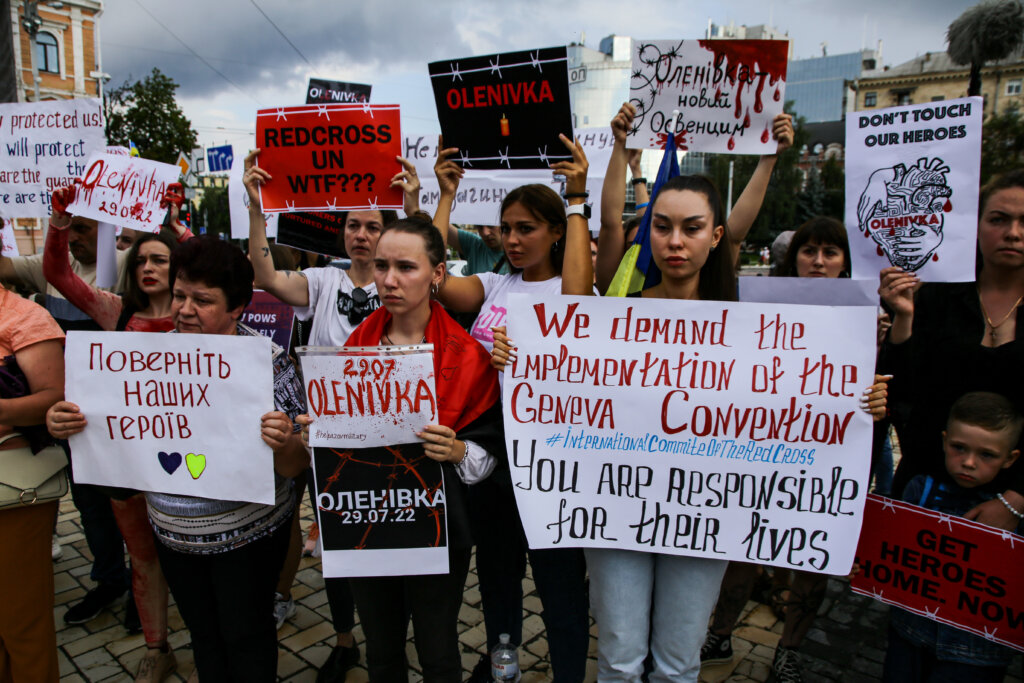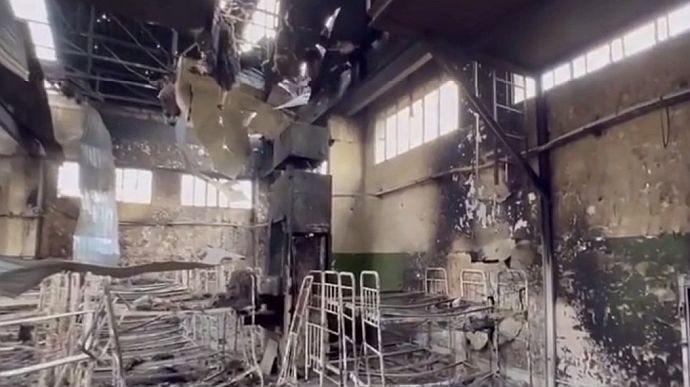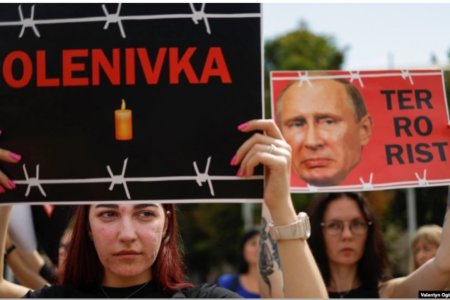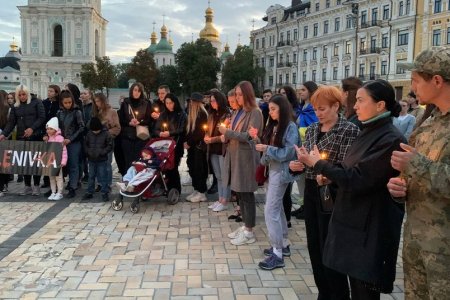
The United Nations High Commissioner for Human Rights Volker Türk has publicly rejected Russia’s claim that the catastrophic explosion at the Russian-controlled prison in Olenivka a year ago was caused by a Ukrainian-fired HIMARS missile. He also noted Russia’s effective blocking of any proper investigation to uncover the cause of an explosion that killed at least fifty prisoners of war and injured many others. While Russia’s obstruction is making an official investigation impossible, the Media Initiative for Human Rights [MIHR] has been able to establish more details about what it clearly describes as a war crime – namely the killing of Ukrainian defenders who were protected by international law as prisoners of war.
As reported, Russia immediately claimed that the explosion during the night from 28-29 July 2022 had been caused by an American HIMARS-launched Ukrainian missile. This was dismissed as nonsense by Kyiv which called for an official investigation. While Moscow claimed, the day after the disaster, that it was inviting both a United Nations and the International Committee of the Red Cross [ICRC] to investigate, this soon proved to be empty words for media headlines. ICRC reported on 3 August that it had not been given access to the site, with that remaining the case to this day. The plan reported on 3 August by UN Secretary-General Antonio Guterres to launch a fact-finding mission came to nothing as Russia failed to provide guarantees of safety for members of the delegation. On 5 January 2023, the Secretary-General announced that the mission had been disbanded.
In the statement released on 25 July 2023, Volker Türk pointed out that Russia had failed not only to guarantee secure access to Olenivka. but was also preventing access to other parts of Ukraine under occupation. This, however, had not succeeded in fully blocking an investigation. The UN’s Office had “conducted extensive interviews with survivors” and had “undertaken detailed analysis of available additional information”.
While not answering all questions, “the information available and our analysis enable the Office to conclude that it was not caused by a HIMARS rocket. Based on the information available, it is not possible at this stage to establish either the specific source of the explosion, nor the exact direction from which a weapon may have been fired.” The Office stresses that prisoners of war are protected by international law and that Russia, as the ‘detaining power’, was obliged to carry out an official and thorough investigation.
Russia’s behaviour makes it quite clear that there is no chance of this happening. While blocking international bodies from visiting the site, it brought in former Hollywood actor, turned Kremlin apologist, Steven Seagal for a propaganda stunt at the site. Even if it now backs away from its original assertion that Ukraine had bombed its own defenders, using a US-provided HIMARS missile launcher, there would be no grounds for believing that any revised explanation was based on an independent investigation.
Ukraine’s Prosecutor General’s Office and the SBU [Security Service] are carrying out investigations, however these are obviously hampered by the lack of access to the site, and the fact that so many of the witnesses remain in Russian captivity.
The Media Initiative for Human Rights (MIHR) has been trying to establish what happened at the Olenivka camp, where Russia is holding both Ukrainian prisoners of war and civilian hostages, since immediately after the tragedy. From the beginning, witnesses near the scene spoke of an explosion, not an airstrike or shelling, as Russian was claiming. In their latest report, Tetiana Katrychenko and Maria Klymyk from MIHR note that there are details which remain unknown, including the identity of those who organized and carried out the crime. The latter, they add, deliberately hid behind masks to conceal their identity.
Families of those defenders from the Azov Regiment and National Guard who were killed or injured, as well as the few defenders who have been released in exchanges fear that the investigation is not moving. They believe there is a real danger that those responsible will not be held to answer. This, of course, is precisely what Russia is trying to achieve by blocking international fact-finding missions.
The report speaks of 193 Azov defenders having been imprisoned in the relevant barracks at Olenivka during the night from 28 to 29 July 2022. At least one, but probably two, major explosions in the barracks caused death and injury, and also led to a huge fire. Around 50 prisoners of war were killed and over 70 others seriously injured. These are the figures that were mentioned from the outset, however the Prosecutor General’s Office spoke in January 2023 of a smaller number, around 40 killed.

MIHR now believes that there were three explosions, two of them in the barracks where the 193 men were held, and one beyond the territory of the prison. It remains unclear what exactly exploded. Since the Russians have, at least up till now, claimed that this was a HIMARS-launched missile attack, despite considerable evidence to the contrary, they clearly have no interest in probing into the real causes.
Russia showed what it claimed to be the remains of a HIMARS system, however reports back in 2022 cast serious doubt over that version, with the UN’s Human Rights Office now rejecting it altogether.
One of the gruesome reasons was that the photos showed charred bodies and other damage which were not in keeping with the uses of HIMARs-launched missiles.
From the outset, there were grounds for suspecting a deliberate attack on the Azov defenders. MIHR has spoken with several witnesses, including Yevhen, a solder from Ukraine’s National Guard. He told them that two barracks were built on the site just two weeks before the disaster, one intended for 200, the other significantly smaller. He explained that POWs had been deployed for the construction work which was suddenly made extremely urgent.
There were various guesses as to the purpose of the new barracks for 200 prisoners which was in the work zone, and isolated from the rest of the prison territory. One suggestion put forward was that it was to be used for women prisoners.
MIHR now reports that on 26 July, guards appeared at the barracks where Azov Regiment POWs were held. An individual, referred to as ‘Tretiy’ [‘Third’] from the proxy ‘Donetsk people’s republic’ read out the names. Those named were from different units within Azov, and included both officers and rank and file soldiers. It remains unclear how the individual names were selected. What is relevant, and sinister, is that only Azov Regiment POWs were included, including representatives of all units, medics, etc, and not one member of another military formation. According to one of the men later released, the Azov men immediately drew up a list of who was held there, 198 men in all. Five, however, were immediately sent to the Donetsk SIZO, which the Russians are also using as a prison, with this leaving 193.
The first explosion, around 23.30 was that outside, then came those in the barracks. It is clear from the accounts given by some of the survivors that many of the defenders were killed, or seriously injured from the explosions, even before the fire broke out.
Those who had survived the explosions tried to drag others to relative safety, and also shouted for help, with nobody answering. The one person who came out with a machine gun began shooting, though he did not shoot any of the POWs. Those survivors, including a medic, who spoke with MIHR stress that the Russians in charge made no attempt at all to safe those wounded.
Between 2 and 3 a.m., however, medics from among the other POWs were allowed onto the path directly outside the barracks. This made the situation a little easier, but one of the medics brought in points out that they were only allowed on that path, not insider the building. This meant that they could only help those who were able to get out by themselves, or who were helped out by another prisoner. He says it would be impossible to be prepared for what they saw that night, with blood all over the road, and people simply crawling, with horrific injuries and limbs blown off. Some died in their arms.
He told them that while the Azov defenders were dying, the prison administration just looked on from beyond the fence. It was clear that they were not worried about repeat strikes, with this another indicator that the explosions did not come from outside airstrikes or shelling. He says, bitterly, that they were not far from clapping at what was happening.
Military trucks (KAMAZ) appeared at around 5 a.m., with the seriously injured piled into this, rather than transported by ambulance, to hospitals in occupied Donetsk.
The first list was issued by Russia’s defence ministry in the morning of 29 July 2022, with this giving the names of 53 who had probably been killed, with 75 injured. The bodies of the victims were kept on the territory of Olenivka prison, with the Russians holding them in basements, not refrigerated facilities. This has further impeded the criminal investigation as, by the time, the bodies were returned, the conditions they had been held in made proper examinations impossible.
While there are differing suggestions put forward as to the cause of the explosions, the witnesses with whom MIHR spoke are convinced that the Azov defenders were deliberately killed. They point to the speed with which the barracks in the work (literally, industrial) zone were prepared and so that they were separate from the other buildings. It is surely telling that not a single guard was injured that night. Suspicion is only heightened by the fact that a list of Azov defenders for the new barracks had been prepared in advance.
If this was deliberate, it was clearly a war crime, since the prisoners of war were in Russian custody and should have been protected, under international law, not murdered. MIHR, however, believes that the Russians restricted the number of people who knew about this plan. While they cannot be sure of all those involved, one who must certainly have known was Serhiy Yevsiukov, the head of Olenivka. He and his deputies were among those who, according to witnesses, simply drank coffee as men died in agony.


